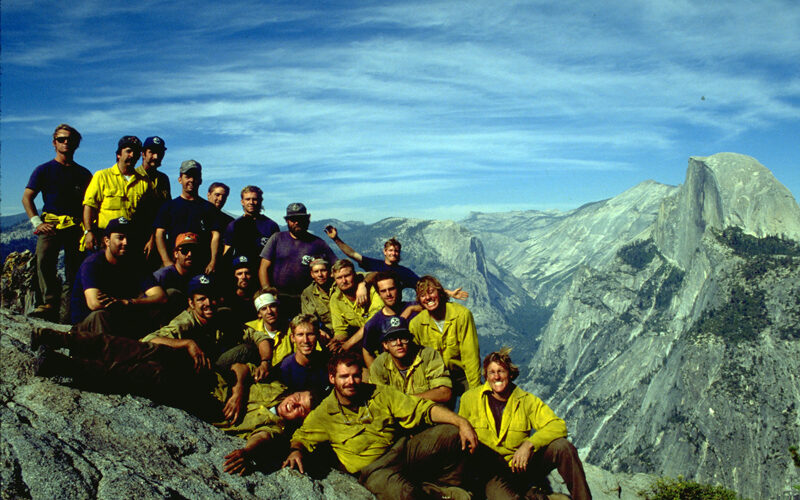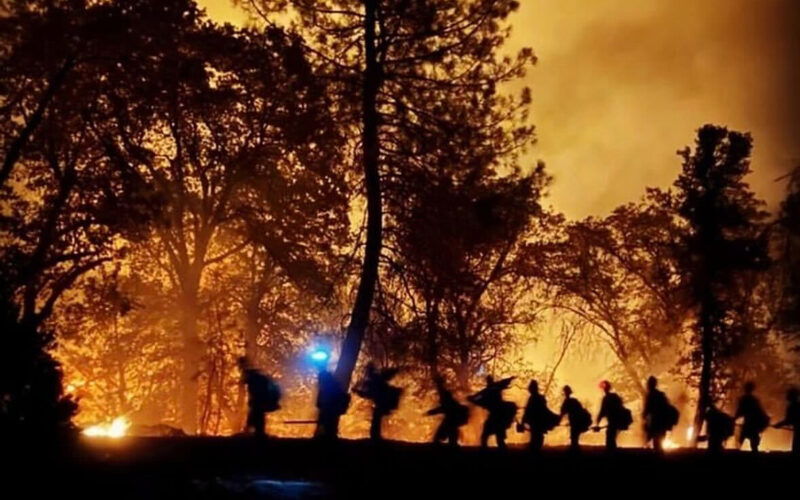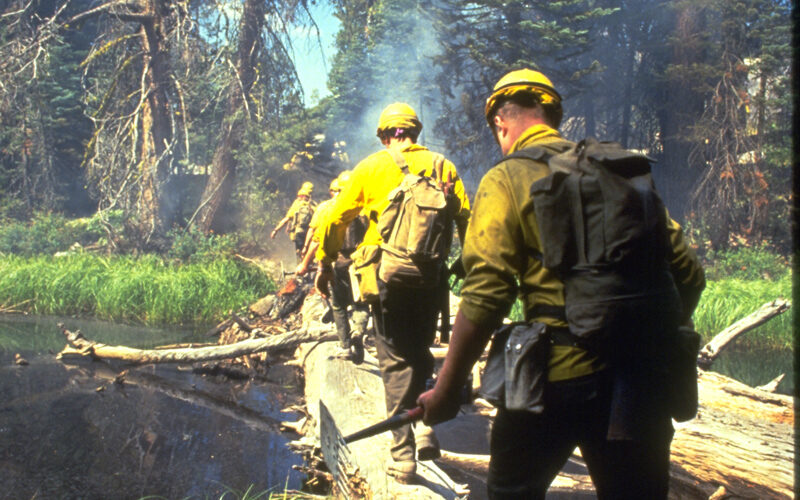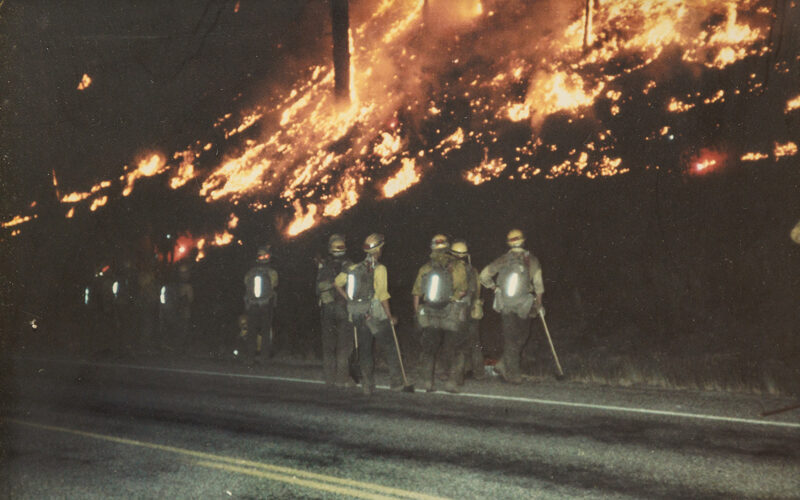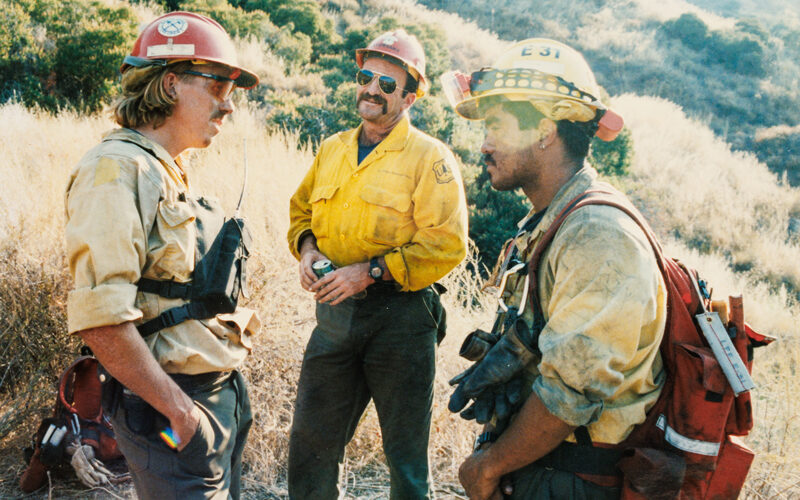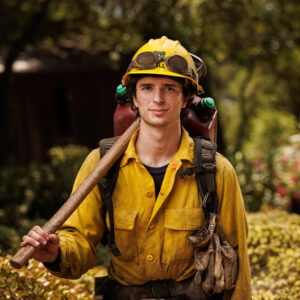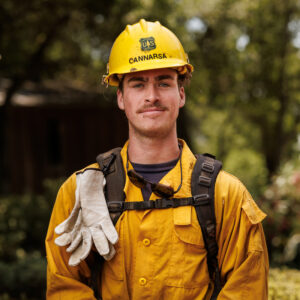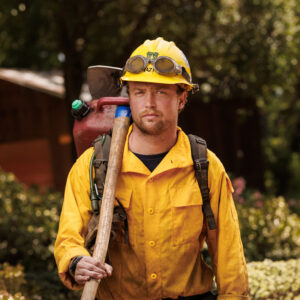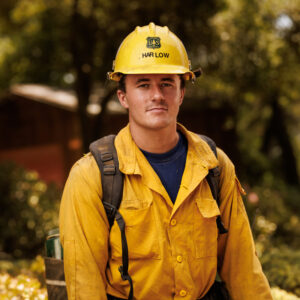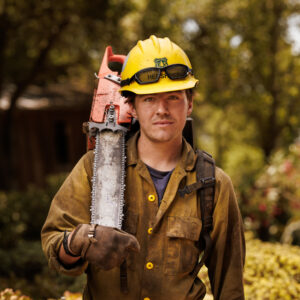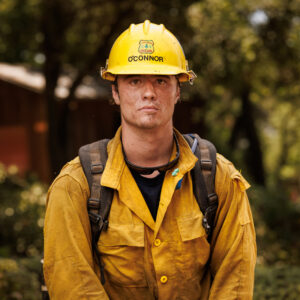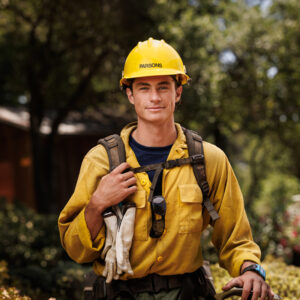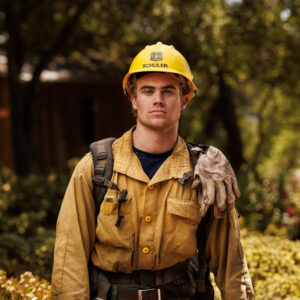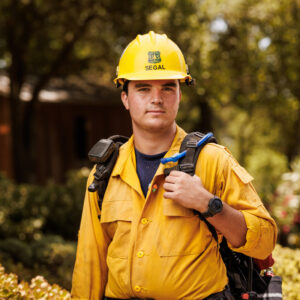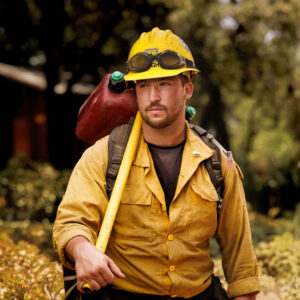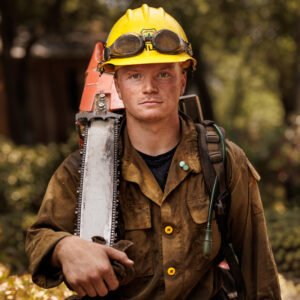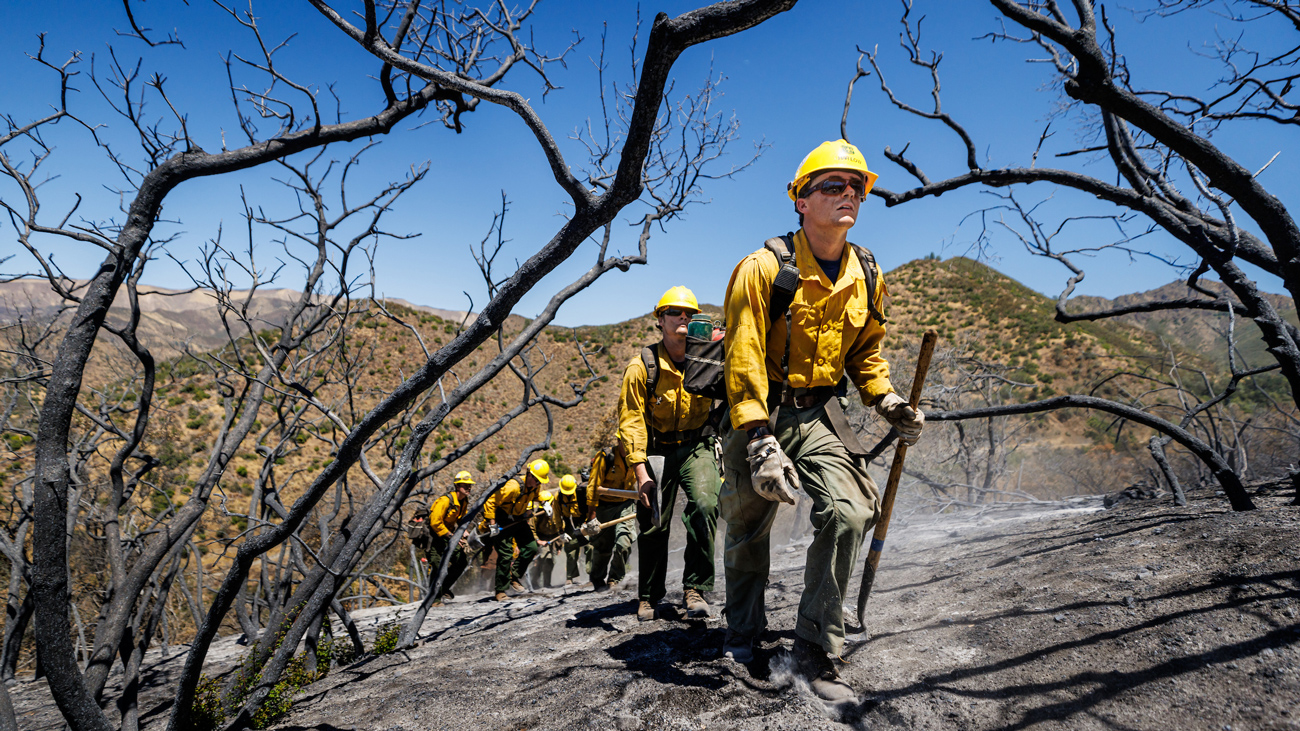
Five days before the 2023 fall quarter started, environmental management and protection major Tyler Riley wrapped up his final shift of the summer with Santa Lucia Crew 7, a Type II firefighting handcrew based in the Los Padres National Forest.
He and other crew members, many of whom were also Cal Poly students, wearily left the district office in Santa Maria to make the commute home. But as soon as he walked through the door of his San Luis Obispo apartment, his phone went off.
A friend from the crew was on the line: a fire had broken out off Highway 166 east of Santa Maria, and they had been called back to help. He’d be at Riley’s house in five minutes. Was Riley ready to go?
“I hadn’t even taken off my boots,” Riley remembers. Soon, they were heading back down to battle one more blaze.
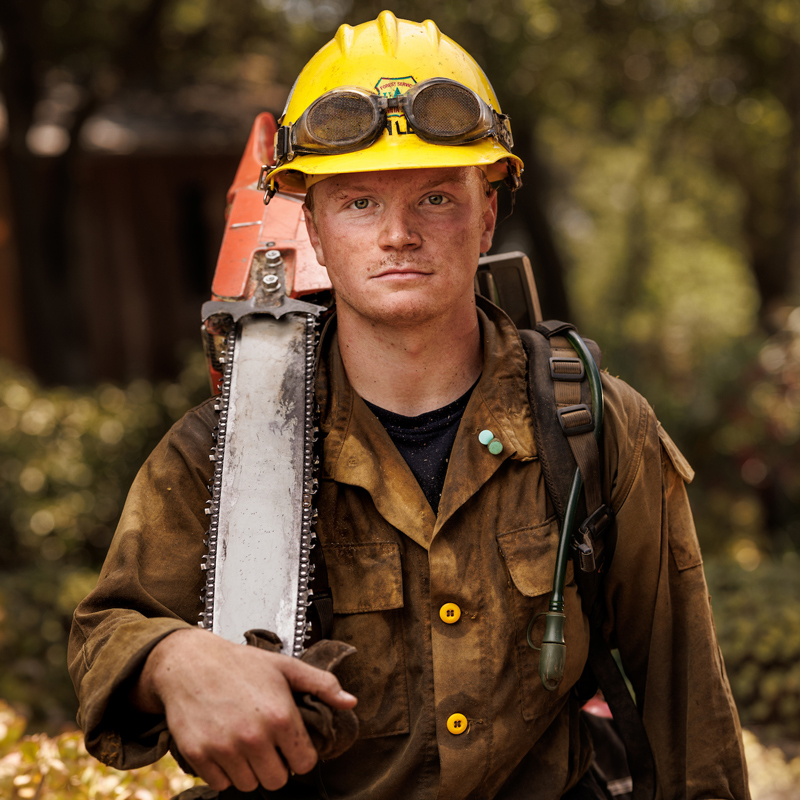
Tyler Riley, a third-year environmental management and protection major and a member of Santa Lucia Crew 7, poses with the chainsaw he uses on the fireline. Photo by Joe Johnston.
“All my friends are back in town and going out, having fun, and I’m out there cutting line,” Riley said, laughing. “At first, I didn’t want to go, but the second we got out there I knew there was no place I’d rather be.”
Riley, who returned to Crew 7 in 2024, relayed this story in mid-June, outside a classroom where this summer’s crew was undergoing training.
“I learned things at Cal Poly that I could then immediately transfer and put into play, one summer after my first year in college,” Riley said. “You don’t get that opportunity anywhere else.”
Santa Lucia Crew 7, which operates as part of the U.S. Forest Service and is based in Santa Maria, is active in the summer months. Anyone can join, but a majority of the crew in any given summer tends to come from Cal Poly — thanks to both its seasonal nature and proximity to campus.
It’s respected as a training ground for firefighters, and both current crew members and alumni say that you can find Santa Lucia alumni on just about any fire crew, especially in the western United States. Many use it as the foot in the door for careers in firefighting: going on to work for Cal Fire, the U.S. Forest Service, county fire departments and beyond.
But there’s a bigger reason many students feel at home on the crew: Santa Lucia Crew 7 has had Mustang DNA from the very beginning.
The History of Crew 7
In the early 1970s, natural resources management student Joe Stutler went to professor Wally Mark with a unique senior project proposal. Stutler, who was a smokejumper and a hotshot firefighter with the U.S. Forest Service for about five years before and during his time at Cal Poly, was disappointed with the lack of standardized training firefighters received at the time.
He wanted to change that.
Under Mark’s advisement, Stutler designed and wrote a training manual and taught a class, known as NRM 338X, that gave students physical fitness training, taught them how to construct fireline, and developed other necessary firefighting skills.
“By the end of the quarter, every one of those folks was qualified as wildland firefighters,” Stutler said. That class evolved into the Cal Poly Thermos, which saw their first fire season in the summer of 1974, according to Stutler. That crew is now Santa Lucia Crew 7.
“I saw this as an opportunity for people to explore whether they wanted to be a wildland firefighter or not,” Stutler said. “It’s one thing to think you want to be until you get a face full of smoke and have to work 16-hour days for 14 days straight and eat bad food and sleep in the dirt. You’ll find out whether you like it or not pretty quick.”
Dan Turner, the now-retired chief of Cal Fire San Luis Obispo, assisted Joe Stutler in the very first class of what eventually became Santa Lucia Crew 7 when they were both students. To him, the crew is a chance to learn all about people: how to work with them, communicate with them and build a team.
“I think it’s outstanding — whether or not students decide to pursue a career in fire service, the team spirit that gets created by working in crews is amazing,” said Turner, who is also the founding director of the Wildland-Urban Interface Fire Institute at Cal Poly and executive director of the San Luis Obispo County Fire Safe Council. “You learn to depend on each other, trust each other, understand strengths and weaknesses. It creates a cohesive unit and a team effort that continues as you work in a fire service career, or if you choose another career.”
Doug Aversano first encountered the crew in the early 1980s, when he went out on wildfires with them as a trainee crew boss. He noted that, from the Forest Service perspective, Crew 7 provided an opportunity to train crew bosses and supervisors.
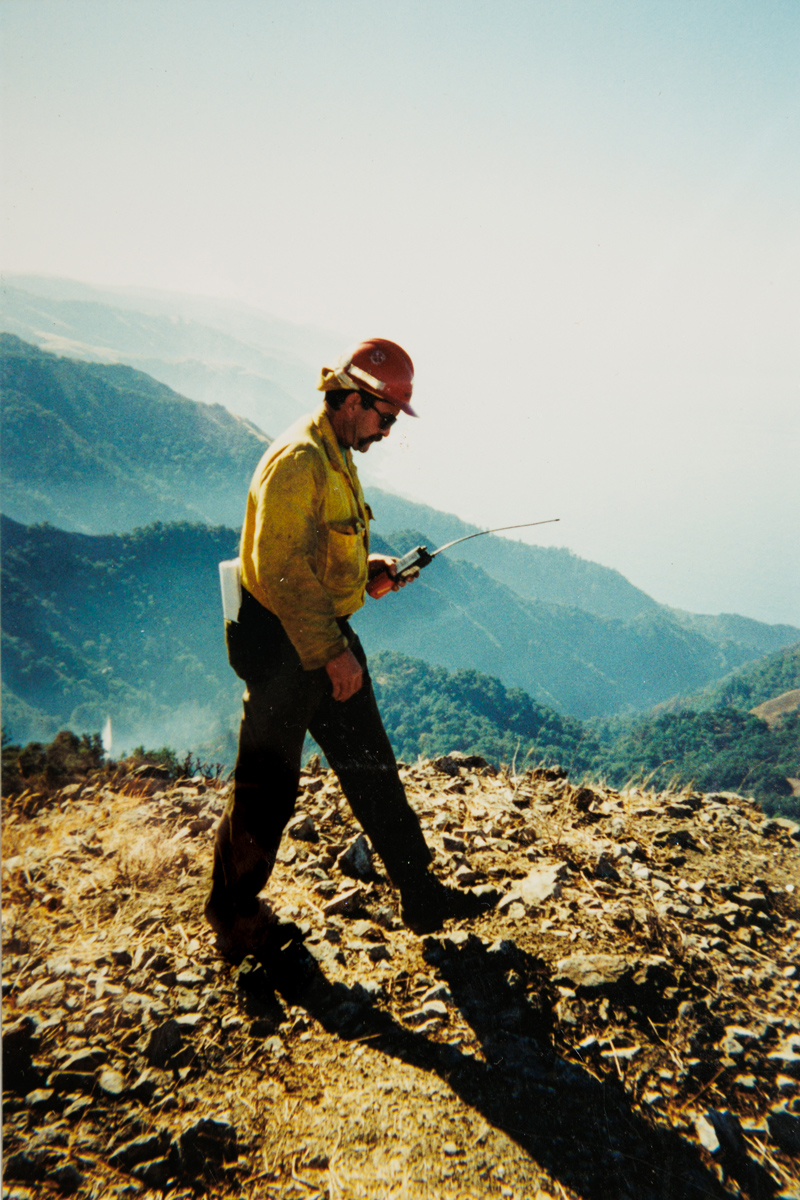
Doug Aversano listens to the radio during the Kirk Fire in Big Sur in 1999. Courtesy of Doug Aversano.
“When you’ve proved yourself and have passed the requisite tests to be called a crew supervisor, a crew boss, that was always a big deal. Because that’s saying, ‘We’re letting you take these firefighters out, and you need to bring them back.’ That’s the bottom line,” Aversano said. “And that was one of the proudest things I ever did: I led these 20-person crews and I got everybody back OK.”
A few years later, in 1987, Aversano became the Crew 7 supervisor, a position he held until 2001. Now a fire science lecturer at Cal Poly, he says he still tells students in his classes that if they want real-world experience, they should consider joining Santa Lucia Crew 7.
“I’ve seen kids go from just starting out, didn’t know how to hold a shovel, to becoming a crew leader,” Aversano said as he sat in his office at Cal Poly, surrounded by photographs and memorabilia from his more than 30-year career with the Forest Service. “I respect the job a lot, and I see it as a noble sort of effort, protecting natural resources and people and their houses. It’s not Boy Scouts, it’s not a walk in the park. You’re setting yourself up to join professional wildland firefighters.”
A Hands-on Firefighting Experience
Fourth-year agribusiness major Joe Simard joined Santa Lucia Crew 7 in the summer of 2023. He started out as a lead sawyer, one of several on the crew assigned a chainsaw to cut down brush and trees in service of creating a fireline.
“You’re kind of in a leadership position and having to strategize and at the same time you’re setting the line when we get to a fire, making it kind of like a hiking trail,” Simard said. “You’re working with the rest of the crew to set the tone and communicating how fast or slow to cut.”
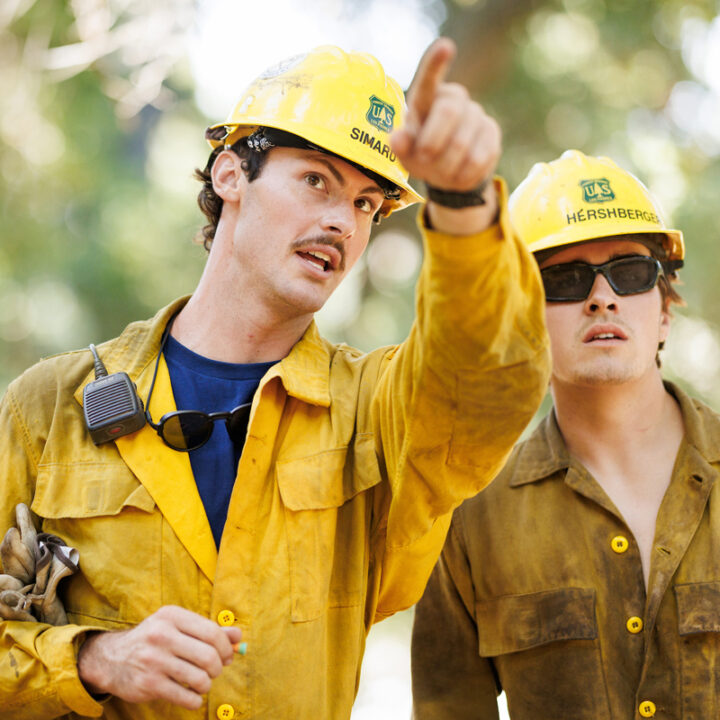
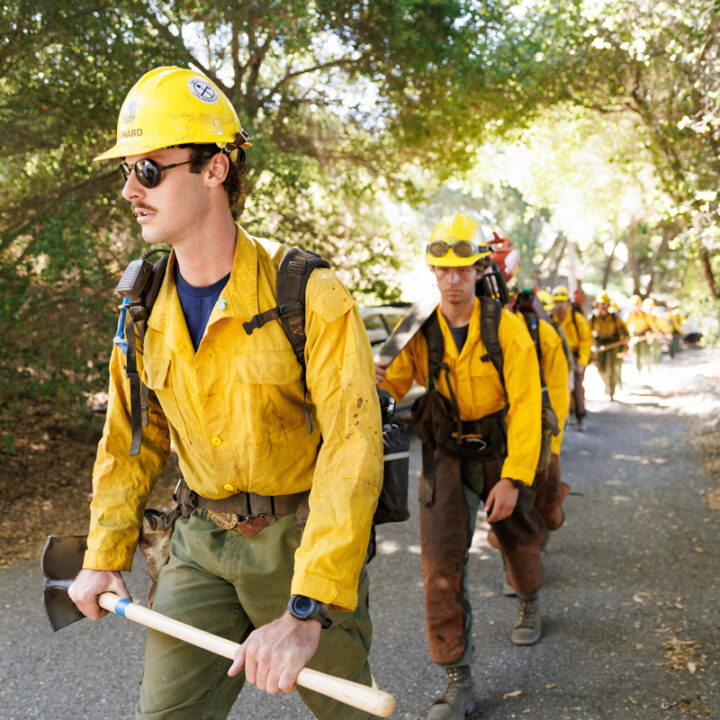
That experience prepared him for his current role as the Alpha, or student lead, for the crew. Simard and Henry Harlow, a fourth-year forestry major and this year’s Bravo — or second student lead — are responsible for communicating with Crew 7’s supervisors and the crew itself. Their largest responsibility is managing the crew’s needs and possible injuries, and making sure their work is done well.
“I chose agribusiness because I wanted to work outside. And then being able to fight fire, I’m like, ‘All right, I can work hard and work outside and get paid to do it all.’ And we help out communities, too,” Simard said. “It’s pretty sweet.”
So far, the 2024 fire season has proven to be busy: just after the crew finished training at the end of June, they were called out to the Basin Fire in Fresno County. After about a week on that fire, they were sent to the Lake Fire in Los Padres National Forest, which eventually burned more than 38,000 acres and was the largest fire in the state when it first broke out.
“It’s definitely a faster start than last year,” Simard said, adding that the crew was excited to help defend their home forest. “Going from a 14,000-acre fire to a 34,000-acre fire in 16 days has been a great way to jump into the season and prepare the crew.”
When the crew was first sent to the Lake Fire, which burned in the backcountry of Santa Barbara County, they had to spike out with two other handcrews, including a hotshot crew, for five days to get a handle on some parts of the fire, Simard said.
“Eating MREs, and putting in long days of line in hot weather, and being ‘stuck’ with each other are the times that test a crew the most,” Simard said, adding that he couldn’t be happier with the crew’s overall attitude and work ethic on the long shifts. “Poison oak was rampant, good sleep was rare, yet smiles were abundant and attitudes were incredibly positive.”
Simard said he’s been able to attend incident briefings and get more familiar with his fellow crew members, their limits and what everyone needs to do their best.
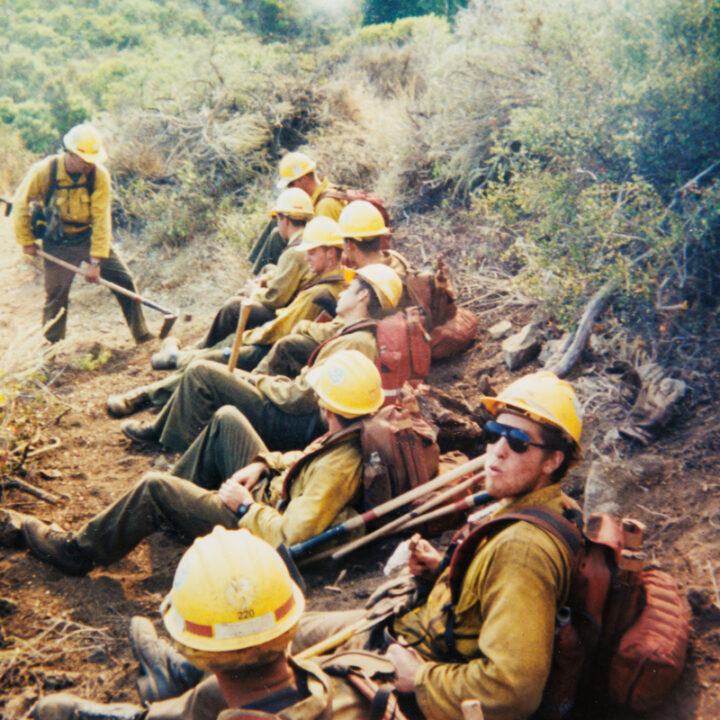
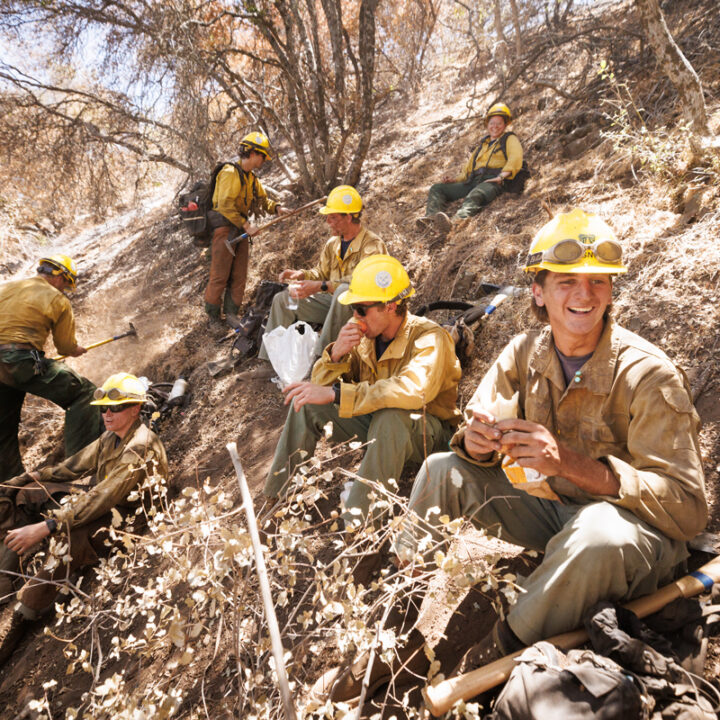
What does that look like on the fireline? It’s imperative that they all understand each other’s normal behavior, especially because weather extremes can cause it to change — and they have to deal with high temperatures, he said. Key things he pays attention to are whether someone’s acting off, if someone needs a break, if the crew is being pushed too hard or if they can be pushed harder.
Simard hopes to put all these lessons into practice as he pursues a career in the fire service. “There’s always more to learn as a leader,” he said.
Alumni Firefighters
When Brian Roberson arrived at Cal Poly in the fall of 1990, his mom had given him an ultimatum: go to college or join the military. He chose to study forestry and natural resources management but didn’t yet know what to do with it.
“My dorm roommate said, ‘There’s this wildland firefighting class in the spring, do you want to take it?’” Roberson remembered. “He wanted to get into the fire service, and I was just a freshman looking to take interesting classes that I’d never heard of.
Two-thirds of the way through the class, contractors with the Santa Lucia crew came in to see if anyone would be interested in joining that summer. Roberson tried out and made the cut. He returned to the Santa Lucia crew for four summers, becoming a student lead in 1994.
“Living in a Southern California beach community, I didn’t really know this type of work existed,” Roberson said. “I grew up playing team sports, and the thought of working with 20 other young men and women toward a common goal outdoors seemed really exciting and fun and adventurous.”
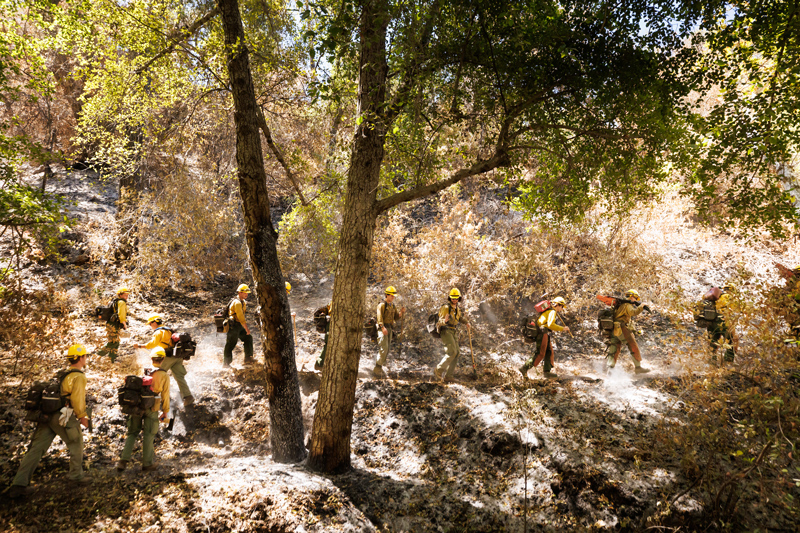
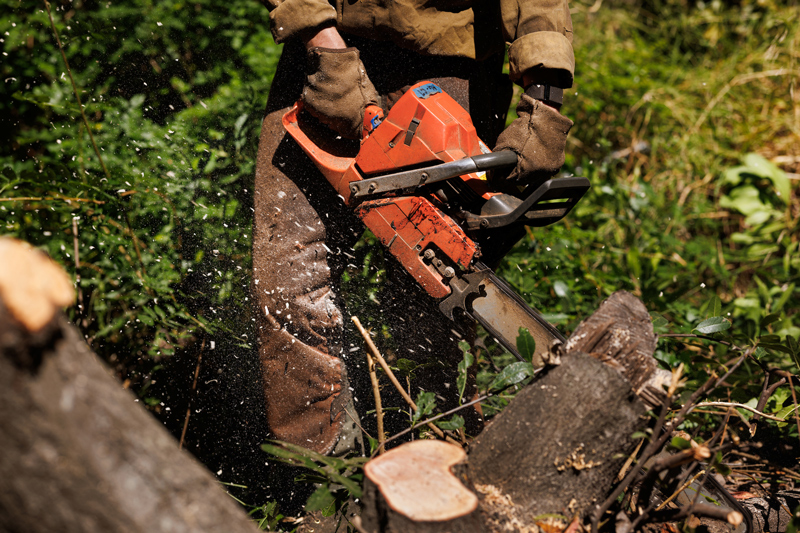
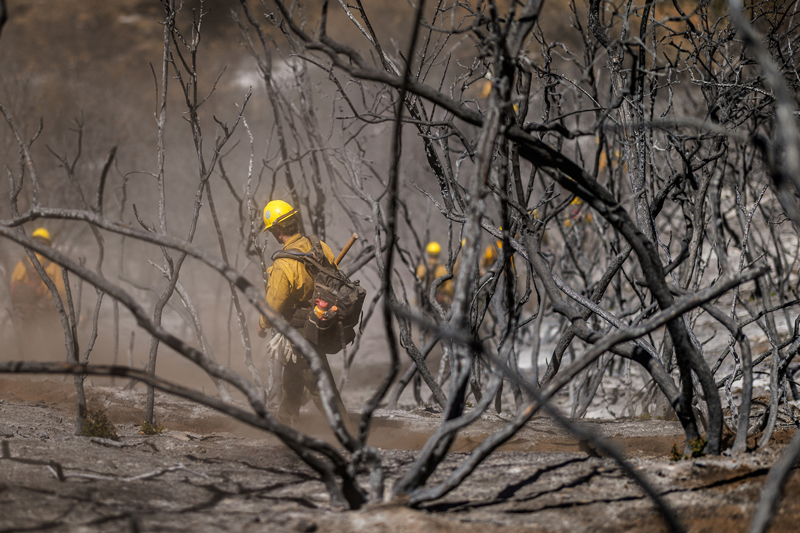
Now a battalion chief in the training division for the Carpinteria-Summerland Fire Protection District, Roberson credits his college experiences for giving him the career he has today.
“One of the things that’s great about the Santa Lucia crew and its association with Cal Poly is the ability to go out and do a very hands-on job during the summer and come back in the fall, winter and spring and reimmerse yourself into academics,” Roberson said. He said his foundation at Cal Poly motivated him to keep learning: he went on to earn two master’s degrees, one from Arizona State University and one from UCLA. His graduate research focused on wildfire evacuations and evacuation behavior.
“The value in the [Santa Lucia] program is that it initially got me involved in the fire service and showed me how rewarding the career was,” Roberson said. “The academic side of my education laid the groundwork for me to do graduate work. In addition to physically showing up and helping put out a wildland fire, or structure fire, or helping with a water rescue or cardiac arrest in our community, it prepared me to help give back more to our profession in terms of answering bigger questions that can have an impact on those we serve at a policy level.”
Ethan Schroeder, who graduated from Cal Poly in 2023 and is now on the Ventana Hotshots based out of Camp Roberts, took an introduction to wildland fire class as a general education course at Cal Poly. His instructor was Doug Aversano, who told him all about Santa Lucia Crew 7.
“I had no idea what wildland firefighting even was until I took that class, I just took it because I was interested in being a municipal firefighter as a kid,” said Schroeder, who majored in business with a concentration in finance. He signed up in 2021, working both that summer and the next.
“It was definitely an eye-opening experience,” Schroeder said, adding that he had never worked that hard or put in hours that long before. “It was a great opportunity to learn about myself and grow as an individual through pushing myself physically and mentally.”
Schroeder said he loved going into backcountry areas with the crew, and the new friends he made who weren’t business majors.
“Crew 7 was the best hands-on Learn by Doing opportunity I ever got,” Schroeder said. “The whole job is about getting things done safely and efficiently, and it really helped develop my critical thinking skills under pretty high-stress situations. Everyone relies on one another to get their jobs done, so it also helped develop my own accountability and work ethic because I never wanted to let the crew down.”
“It’s an excellent training ground for wildland firefighting,” said Mike McMillan, a Santa Lucia crew member from 1988 to 1990 and in 1992. “A handcrew requires you to carry everything you need to be self-sufficient while being part of a team, accomplishing great amounts of physical work with an end goal of protecting values at risk: whether that’s animal habitat or commercial buildings and residences.”
This gives people an opportunity to be something greater than themselves, work as a team, learn leadership and lead from the front and the middle.
McMillan is now a wildland firefighter contracted with the Bureau of Land Management in Boise, Idaho, who serves primarily as a public information officer and task force leader. After his time on the Santa Lucia crew, he joined the Los Padres Hotshots and then worked for 17 years as an Alaska Smokejumper. A journalism major during his time at Cal Poly, McMillan has flexed his photographic and communications skills throughout his career in fire service.
“That crew really offers an opportunity on an entry-level position while still being very demanding and challenging,” McMillan said. “Young men and women have an opportunity to discover more about themselves: their challenges, their strengths. It teaches you how to be competitive and be a leader without being arrogant, abrasive, obnoxious.”
Firefighting in California
Fifty years on, the Santa Lucia crew’s impact goes beyond physically battling one of California’s — and the West’s — greatest environmental threats.
Looking back on his time with the Cal Poly Thermos, Joe Stutler said the experience helped him become a good leader. Since then, he’s been the incident commander for incident management teams that responded to major events including Ground Zero on 9/11 and Hurricane Katrina before retiring from the Forest Service, moving to Oregon and becoming the Deschutes County Forester, a position he has held for the last 20 years. With 56 years of wildland fire experience, Stutler still responds as an incident commander or deputy incident commander to large wildfires under an agreement with the Forest Service.
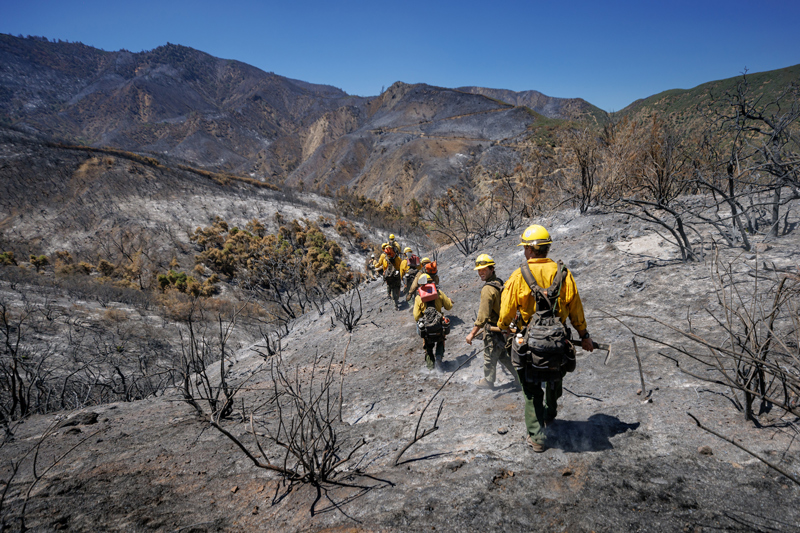
Crew 7 crests a hillside in the Lake Fire burn scar in Santa Barbara County. Photo by Joe Johnston.
“I knew I was doing something right when I watched them do what I would have done,” Stutler said of the Santa Lucia crew. “The best thing you can do is train your successors. When I think about the number of people who came through that program, they did pretty damn good. They had a lot of good work ethic, and they decided to make something of it.”
Doug Aversano said he always made it clear to his teams that they weren’t there to observe and get told what to do: they were there to work hard and take initiative when needed.
“I just tried to make them the best team I could to help them learn,” Aversano said. “I love the kids that were going to school here. They had a desire to do well.
“The makeup of a lot of the folks was wanting to take initiative, wanting to be in good shape, do a good job, represent themselves and their crew — and by and large, go kick ass.”
The future of wildfires is changing. On the first day of his classes, Aversano says he usually asks students why they chose the course. In his early years of teaching, students would point to camping experience, or being a Boy or Girl Scout. But in the last ten years, he’s gotten more and more students who’ve said they chose a class on wildland fire because they’ve either had to evacuate from a wildfire, or they’ve watched the places important to them burn down in one.
In the last decade, California has seen nine of the largest wildfires in its history. If you ask Stutler, he says he’d like to see another crew like Santa Lucia get started to train even more people in firefighting.
“It’s a completely different environment now. There are no fire seasons, just fire years. Sometimes I think it’d be great to be a young whippersnapper to learn and be part of what’s to come in the next 20, 30 years. It’s much bigger than a fire crew,” Stutler said. “This gives people an opportunity to be something greater than themselves, work as a team, learn leadership and lead from the front and the middle.”

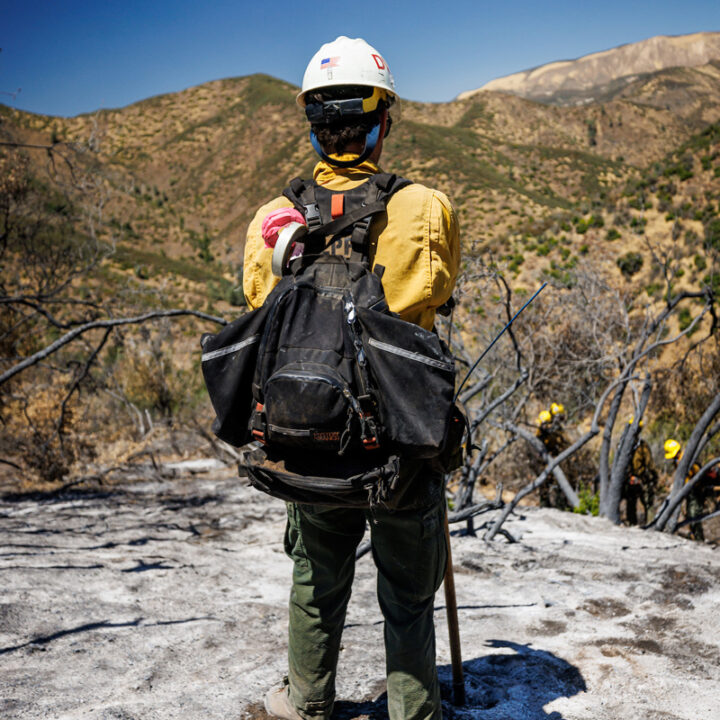
“I didn’t realize it, when I first applied to Santa Lucia, what I was really getting into,” Brian Roberson said. “Serving the community is just a really rewarding feeling. Ultimately, the service, doing something good for society and for people is deep down the driving thing that kept me in this profession and interested in progressing and spending my whole career in fire service. Santa Lucia was really instrumental in that.”
When asked why people should join Santa Lucia Crew 7, Aversano pointed to its good reputation and the opportunity for real-world experience. But he also wants to see students carry on the crew’s legacy.
“Go fight fire, and do it safely,” he said. “Keep the tradition going.”


